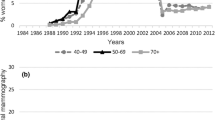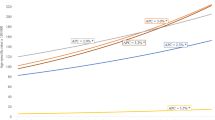Abstract
Objective
To compare the distribution of stage at breast cancer diagnosis between First Nations (FN) and non-FN women, and to investigate factors associated with later diagnosis in FN women.
Methods
A case-case design was employed to compare FN women (N=287) to a frequency-matched random sample of women (N=671) from the general population diagnosed with breast cancer in the Ontario Cancer Registry. Women were matched (2:1) on period of diagnosis (1995–1999, 2000–2004), age at diagnosis (<50 vs. ≥50), and Regional Cancer Centre (RCC). Stage and data relevant to the determinants of stage were collected from medical charts at the RCCs. The association between stage (stage II+ vs. I) and FN status was modeled using logistic regression analyses; for FN women, the association between risk factors and stage was examined.
Results
FN women (66%) were diagnosed with a later stage significantly more often than non-FN women (56%). FN women with a non-screened cancer (OR 5.03, 95% CI 2.48–10.21) and those who were overweight or obese (OR 2.98, 95% CI 1.27–6.98 and OR 4.46, 95% CI 1.95–10.21, respectively) were significantly more likely to be diagnosed at a later stage. Having a comorbidity reduced the odds of a later stage (OR 0.51, 95% CI 0.27–0.96) in FN women.
Conclusion
This study demonstrates the need for FN women, in particular those who are not accessing the health care system, to participate in breast screening programs aimed at detecting breast cancers earlier with a better prognosis. These findings suggest that the cancer care system in Ontario should better target this population through increasing awareness and access to screening.
Résumé
Objectifs
Comparer la répartition des stades du cancer du sein au moment du diagnostic entre les femmes membres des Premières nations (PN) et les femmes qui n’en sont pas membres (non-PN), et étudier les facteurs associés au diagnostic tardif chez les femmes des PN.
Méthode
Nous avons mené une étude cas-cas pour comparer les femmes des PN (n=287) à un échantillon aléatoire apparié selon la fréquence, composé de femmes (n=671) de la population générale ayant un diagnostic de cancer du sein selon le Registre d’inscription des cas de cancer de l’Ontario. Les femmes ont été appariées (2:1) selon la période du diagnostic (1995–1999, 2000–2004), l’âge au diagnostic (<50 ans ou ≥50) et le Centre régional de cancérologie (CRC). Le stade et les données liées aux déterminants du stade ont été obtenus dans les dossiers médicaux des CRC. L’association entre le stade (stade II+ ou stade I) et l’appartenance ou non aux PN a été modélisée par régression logistique; pour les femmes des PN, nous avons examiné l’association entre les facteurs de risque et le stade.
Résultats
Les femmes des PN (66%) ont été diagnostiquées à un stade plus tardif significativement plus souvent que les femmes non-PN (56%). Les femmes des PN ayant un cancer non dépisté (RC 5,03, IC 95% 2,48–10,21) et celles qui faisaient de l’embonpoint ou qui étaient obèses (RC 2,98, IC 95% 1,27–6,98 et RC 4,46, IC 95% 1,95–10,21, respectivement) étaient de manière significative plus susceptibles de recevoir un diagnostic à un stade plus avancé. La présence d’une comorbidité réduisait la probabilité d’un diagnostic tardif (RC 0,51, IC 95% 0,27–0,96) chez les femmes des PN.
Conclusion
Cette étude montre que les femmes des PN, en particulier celles qui ne font pas appel au système de santé, auraient besoin de participer à des programmes de dépistage du cancer du sein qui visent à détecter ces cancers plus tôt pour en améliorer le pronostic. Le système de soins en cancérologie de l’Ontario devrait donc mieux cibler cette population en améliorant la sensibilisation et l’accès au dépistage.
Similar content being viewed by others
References
Canadian Cancer Society/National Cancer Institute of Canada. Canadian Cancer Statistics 2009, Toronto.
Marrett LD, Chaudhry M. Cancer incidence and mortality in Ontario First Nations, 1968–1991 (Canada). Cancer Causes Control 2003;14(3):259–68.
Health Canada. A Statistical Profile on the Health of First Nations in Canada. First Nations and Inuit Health Branch, 2003.
Mahoney MC, Michalek AM. A meta-analysis of cancer incidence in United States and Canadian native populations. Int J Epidemiol 1991;20(2):323–27.
Rosenberg T, Martel S. Cancer trends from 1972–1991 for Registered Indians living on Manitoba Reserves. Int J Circumpolar Health 1998;57(Suppl 1):391–98.
Condon JR, Barnes T, Armstrong BK, Selva-Nayagam S, Elwood JM. Stage at diagnosis and cancer survival for Indigenous Australians in the Northern Territory. Med J Aust 2005;182(6):277–80.
Samet JM, Key CR, Hunt WC, Goodwin JS. Survival of American Indian and Hispanic cancer patients in New Mexico and Arizona, 1969–82. J Natl Cancer Inst 1987;79(3):457–63.
Dennis TD. Cancer stage at diagnosis, treatment, and survival among American Indians and non-American Indians in Montana. Cancer 2000;89(1):181–86.
Tillman L, Myers S, Pockaj B, Perry C, Bay RC, Al-kasspooles M. Breast cancer in Native American women treated at an urban-based Indian health referral center 1982–2003. Am J Surg 2005;190(6):895–902.
Wampler NS, Lash TL, Silliman RA, Heeren TC. Breast cancer survival of American Indian/Alaska Native women, 1973–1996. Soz Praventivmed 2005;50(4):230–37.
Jeffreys M, Stevanovic V, Tobias M, Lewis C, Ellison-Loschmann L, Pearce N, et al. Ethnic inequalities in cancer survival in New Zealand: Linkage study. Am J Public Health 2005;95(5):834–37.
Maskarinec G, Pagano IS, Yamashiro G, Issell BF. Influences of ethnicity, treatment, and comorbidity on breast cancer survival in Hawaii. J Clin Epidemiol 2003;56(7):678–85.
Sugarman JR, Dennis LK, White E. Cancer survival among American Indians in western Washington State (United States). Cancer Causes Control 1994;5(5):440–48.
Frost F, Tollestrup K, Hunt WC, Gilliland F, Key CR, Urbina CE. Breast cancer survival among New Mexico Hispanic, American Indian, and non-Hispanic white women (1973–1992). Cancer Epidemiol Biomarkers Prev 1996;5(11):861–66.
Valery PC, Coory M, Stirling J, Green AC. Cancer diagnosis, treatment, and survival in Indigenous and non-Indigenous Australians: A matched cohort study. Lancet 2006;367(9525):1842–48.
Rosenberg J, Chia YL, Plevritis S. The effect of age, race, tumor size, tumor grade, and disease stage on invasive ductal breast cancer survival in the U.S. SEER database. Breast Cancer Res Treat 2005;89(1):47–54.
McBride R, Hershman D, Tsai WY, Jacobson JS, Grann V, Neugut AI. Within-stage racial differences in tumor size and number of positive lymph nodes in women with breast cancer. Cancer 2007;110(6):1201–8.
Begg CB, Zhang ZF. Statistical analysis of molecular epidemiology studies employing case-series. Cancer Epidemiol Biomarkers Prev 1994;3(2):173–75.
American Joint Committee on Cancer. Cancer Staging Manual. New York, 2002.
Groome PA, Schulze KM, Keller S, Mackillop WJ. Demographic differences between cancer survivors and those who die quickly of their disease. Clin Oncol (R Coll Radiol) 2008;20(8):647–56.
National Institutes of Health: Clinical Guidelines on the Identification, Evaluation, and Treatment of Overweight and Obesity in Adults—The Evidence Report. National Institutes of Health. Obes Res 1998;6(Suppl 2):51S–209S.
Charlson ME, Pompei P, Ales KL, MacKenzie CR. A new method of classifying prognostic comorbidity in longitudinal studies: Development and validation. J Chronic Dis 1987;40(5):373–83.
Sagiv SK, Gaudet MM, Eng SM, Abrahamson PE, Shantakumar S, Teitelbaum SL, et al. Active and passive cigarette smoke and breast cancer survival. Ann Epidemiol 2007;17(5):385–93.
Condon JR, Cunningham J, Barnes T, Armstrong BK, Selva-Nayagam S. Cancer diagnosis and treatment in the Northern Territory: Assessing health service performance for indigenous Australians. Intern Med J 2006;36(8):498–505.
Jacobellis J, Cutter G. Mammography screening and differences in stage of disease by race/ethnicity. Am J Public Health 2002;92(7):1144–50.
Gracey M, King M. Indigenous health part 1: Determinants and disease patterns. Lancet 2009;374(9683):65–75.
Fleming ST, Pursley HG, Newman B, Pavlov D, Chen K. Comorbidity as a predictor of stage of illness for patients with breast cancer. Med Care 2005;43(2):132–40.
Minore B, Boone M, Katt M, Kinch P, Birch S, Mushquash C. The effects of nursing turnover on continuity of care in isolated First Nation communities. Can J Nurs Res 2005;37(1):86–100.
Minore B, Boone M, Katt M, Kinch P, Cromarty H. How clients choices influence cancer care in northern Aboriginal communities. Int J Circumpolar Health 2004;63(Suppl 2):129-32.
Friedman DB, Hoffman-Goetz L. Assessment of cultural sensitivity of cancer information in ethnic print media. J Health Commun 2006;11(4):425–47.
Author information
Authors and Affiliations
Consortia
Corresponding author
Rights and permissions
About this article
Cite this article
Sheppard, A.J., Chiarelli, A.M., Marrett, L.D. et al. Detection of Later Stage Breast Cancer in First Nations Women in Ontario, Canada. Can J Public Health 101, 101–105 (2010). https://doi.org/10.1007/BF03405573
Received:
Accepted:
Published:
Issue Date:
DOI: https://doi.org/10.1007/BF03405573




